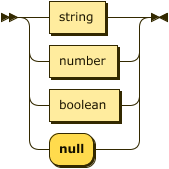4. Examples
This section is informative.
This section details DMPL conforming example programs.
The following sends "hello world" to the action realizer.
{
"@act": "`hello world`"
}
Two actions can be sent sequentially.
{
"@do": [
{"@act": "`hello`"},
{"@act": "`world`"}
]
}
Fork statements allow branching logic.
{
"@fork": [
{"if": ["==", ["+", 2, 2], 4], "@act": "`this statement is run`"},
{"@act": "`never reached`"}
]
}
Variables can be set and accessed like so.
{
"@do": [
{"@set": "`a`", "val": 1},
{"@set": "`b`", "val": 2},
{"@set": "`c`", "val": ["+", "a", "b"]}
]
}
Here we define a new expression called inc which takes an argument called x.
{
"@do": [
{"@def": ["", "`inc`", "`x`"], "val": {"@pop": ["+", 1, "x"]}},
{"@act", ["`inc`", 5]}
]
}
The set statement allows unpacking a list.
{
"@do": [
{"@set": "`content`", "val": ["", "`What's the biggest planet?`", "`Jupiter`"]},
{"@set": ["", "`Prompt`", "`Correct-Answer`"], "val": "`content`"}
]
}
Run an external file and pass in arguments. The return value can be considered in the following fork statement.
{"@do":
{"@run": "`Question`", "args": ["", "`What's the biggest planet?`", "`Jupiter`"]},
{"await": ["return"], "@fork": [
{"if": ["return", true], "@set": "`score`", "val": 100},
{"@set": "`score`", "val": 0}
]}
}
Expressions and variabels may be imported from other files.
{
"@do": [
{"@use": "`MathExpressions`", "import": ["", "`square`", "`exp`"]},
{"@act": ["==", ["`square`", 6], ["`exp`", 6, 2]]}
]
}
To halt until a user input is supplied, the await flag on a fork may be used.
More immersive dialogue can be achieved by setting and checking variables, such as greeted.
{
"scheme": {"depth": 2}, "@fork": [
{"if": ["!", ["exists", "`greeted`"]], "@set": "`greeted`", "val": false},
{"if": ["!", "greeted"], "@do": [
{"@act": "`hello`"},
{"@set": "`greeted`", "val": true}
]},
{"if": "greeted", "@do": [
{"@act": "`how are you?`"},
{"@set": "`asked_feelings`", "val": true},
{"await": ["input"], "@fork": [
{"if": ["input", "`good`"], "@act": "`great`"}
]}
]}
]
}
More complete question and answering scenarios may be constructed.
{
"@fork": [
{"if": ["!", ["exists", "`Init`"]], "@do": [
{"@set": "`Init`", "val": true},
{"@set": "`Wrong-Counter`", "val": 0},
{"@set": "`Is-Hint1-Given`", "val": false},
{"@set": "`Is-Hint2-Given`", "val": false},
{"@set": "`Is-Answer-Given`", "val": false},
{"@set": "`Num-Hints-Given`", "val": 0},
{"@set": "`Question`", "val": "`What's the biggest planet?`"},
{"@set": "`CA`", "val": "`planet.jupiter`"},
{"@set": "`CA-Response`", "val": "`Exactly!`"},
{"@set": "`WA1`", "val": "`planet`"},
{"@set": "`WA1-Response`", "val": "`Nope. That's not the biggest`"},
{"@set": "`WA2`", "val": "`nonplanet`"},
{"@set": "`WA2-Response`", "val": "`That's not a planet`"},
{"@set": "`Hint1`", "val": "`It has a big red spot`"},
{"@set": "`Hint2`", "val": "`It's name begins with the letter J`"},
{"@set": "`Answer`", "val": "`The biggest planet is Jupiter`"},
{"@set": "`Hint-Announcement`", "val": "`Here's a hint`"}
]},
{"@fork": [
{"if": ["&&", ["<=", "Wrong-Counter", 3], ["!", "Is-Answer-Given"]], "@do": [
{"@act": "Question"},
{"@fork": [
{"if": ["input", "CA"], "@do": [
{"@act": "CA-Response"},
{"@set": "`Is-Answer-Given`", "val": true}
]},
{"if": ["input", "WA1"], "@do": [
{"@act": "WA1-Response"},
{"@set": "`Wrong-Counter`", "val": ["+", 1, "Wrong-Counter"]}
]},
{"if": ["input", "WA2"], "@do": [
{"@act": "WA2-Response"},
{"@set": "`Wrong-Counter`", "val": ["+", 1, "Wrong-Counter"]}
]},
{"@do": [
{"@set": "`Wrong-Counter`", "val": ["+", 1, "Wrong-Counter"]}
]}
], "await": ["input"]}
]},
{"if": ["&&", ["!", "Is-Hint1-Given"], ["==", "Wrong-Counter", 1]], "@do": [
{"@act": "Hint-Announcement"},
{"@act": "Hint1"},
{"@set": "`Is-Hint1-Given`", "val": true}
]},
{"if": ["&&", ["!", "Is-Hint2-Given"], ["==", "Wrong-Counter", 2]], "@do": [
{"@act": "Hint-Announcement"},
{"@act": "Hint2"},
{"@set": "`Is-Hint2-Given`", "val": true}
]},
{"if": ["&&", ["!", "Is-Answer-Given"], ["==", "Wrong-Counter", 3]], "@do": [
{"@act": "Answer"},
{"@set": "`Is-Answer-Given`", "val": true}
]}
], "scheme": {"depth": 3}}
]
}
Here's how to handle global interruptions from the user.
{"scheme": {depth: 1}, "@fork": [
{"@do": [
{"@act": "`What's your favorite color?`"},
{"await": ["input"], "@fork": [
{"if": ["input", "`red`"], "@act": "`That's my favorite color, too!`"}
{"@act": "`I've never heard of it`"}
]}
]},
{"if": ["input", "`want to quit`"], "@act": "bye"}
]}
























